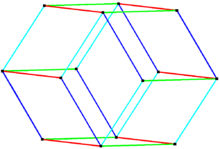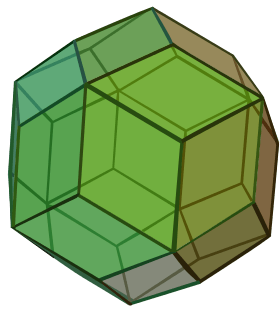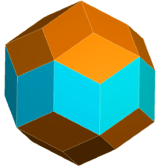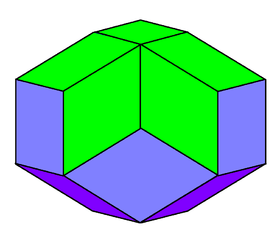Bilinski dodecahedron

In geometry, the Bilinski dodecahedron is a 12-sided convex polyhedron all of whose faces are congruent rhombi. It has the same topology but different geometry from the rhombic dodecahedron, another 12-sided polyhedron with congruent rhombic faces.
History
This shape appears in a 1752 book by John Lodge Cowley, labeled as the dodecarhombus.[1][2] It is named after Stanko Bilinski, who rediscovered it in 1960.[3] Bilinski himself called it the rhombic dodecahedron of the second kind.[4] Bilinski's discovery corrected a 75-year-old omission in Evgraf Fedorov's classification of convex polyhedra with congruent rhombic faces.[5]
Properties

In the rhombi of the Bilinski dodecahedron, the ratio of lengths of the two diagonals is the golden ratio; that is, the faces of this shape are golden rhombi. In contrast, for the standard rhombic dodecahedron the corresponding ratio is the square root of 2.[6]
This shape is a zonohedron. Like the rhombic dodecahedron, it can tile three-dimensional space by translation, making it a parallelohedron.[5]
Relation to rhombic dodecahedron
The Bilinski dodecahedron and rhombic dodecahedron have the same topology: their vertices, edges, and faces correspond one-for-one, in an adjacency-preserving way. However, their geometry is different. In a 1962 paper,[7] H. S. M. Coxeter claimed that the Bilinski dodecahedron could be obtained by an affine transformation from the rhombic dodecahedron, but this is false. For, in the Bilinski dodecahedron, the long body diagonal is parallel to the short diagonals of two faces, and to the long diagonals of two other faces. In the rhombic dodecahedron, the corresponding body diagonal is parallel to four short face diagonals, and in any affine transformation of the rhombic dodecahedron this body diagonal would remain parallel to four equal-length face diagonals. Another difference between the two dodecahedra is that, in the rhombic dodecahedron, all the body diagonals connecting opposite degree-4 vertices are parallel to face diagonals, while in the Bilinski dodecahedron the shorter body diagonals of this type have no parallel face diagonals.[5]
Related zonohedra
The Bilinski dodecahedron can be formed from the rhombic triacontahedron (another zonohedron with 30 golden rhombic faces) by removing or collapsing two zones or belts of faces with parallel edges. Removing only one of these two zones produces, instead, the rhombic icosahedron, and removing three produces the golden rhombohedra.[4][5] The Bilinski dodecahedron can be dissected into four golden rhombohedra, two of each type.[8]
The vertices of these zonohedra can be computed by linear combinations of 3 to 6 vectors. A belt mn means n directional vectors, each containing m coparallel congruent edges. The Bilinski dodecahedron has 4 belts of 6 coparallel edges.
| Belts | 106 | 85 | 64 | 43 |
|---|---|---|---|---|
| Faces | Triacontahedron 30 |
Icosahedron 20 (−10) |
Dodecahedron 12 (−8) |
Hexahedron 6 (−6) |
| Edges | 60 | 40 (−20) | 24 (−16) | 12 (−12) |
| Vertices | 32 | 22 (−10) | 14 (−8) | 8 (−6) |
| Images |   |
 |
||
| Full symmetry |
Ih Order 120 |
D5d Order 20 |
D2h Order 8 |
D3d Order 12 |
References
- ↑ Hart, George W. (2000), "A color-matching dissection of the rhombic enneacontahedron", Symmetry: Culture and Science, 11 (1-4): 183–199, MR 2001417.
- ↑ Cowley, John Lodge (1752), Geometry Made Easy; Or, a New and Methodical Explanation of the Elements of Geometry, London, Plate 5, Fig. 16. As cited by Hart (2000).
- ↑ Bilinski, S. (1960), "Über die Rhombenisoeder", Glasnik Mat. Fiz. Astr., 15: 251–263, Zbl 0099.15506.
- 1 2 Cromwell, Peter R. (1997), Polyhedra: One of the most charming chapters of geometry, Cambridge University Press, Cambridge, p. 156, ISBN 0-521-55432-2, MR 1458063.
- 1 2 3 4 Grünbaum, Branko (2010), "The Bilinski dodecahedron and assorted parallelohedra, zonohedra, monohedra, isozonohedra, and otherhedra" (PDF), The Mathematical Intelligencer, 32 (4): 5–15, doi:10.1007/s00283-010-9138-7, MR 2747698.
- ↑ A new rhombic dodecahedron, Matt Parker, standupmaths
- ↑ Coxeter, H. S. M. (1962), "The classification of zonohedra by means of projective diagrams", Journal de Mathématiques Pures et Appliquées, 41: 137–156, MR 0141004. Reprinted in Coxeter, H. S. M. (1968), Twelve geometric essays, Carbondale, Ill.: Southern Illinois University Press, MR 0310745 (The Beauty of Geometry. Twelve Essays, Dover, 1999, MR 1717154).
- ↑ "Golden Rhombohedra", CutOutFoldUp, retrieved 2016-05-26
External links
- VRML model, George W. Hart: